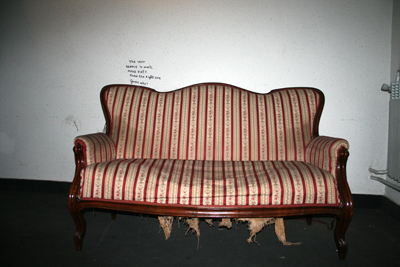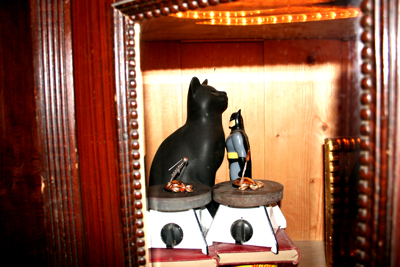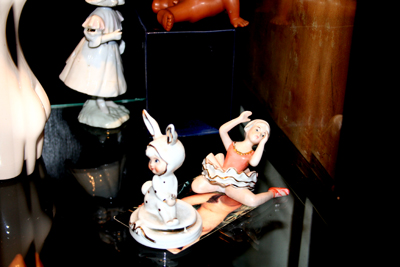code flow - e-texts
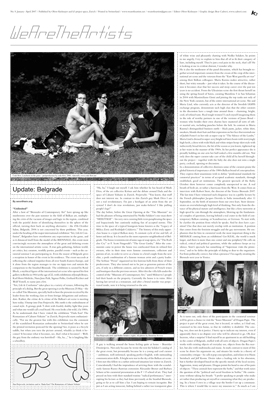 WeAreTheArtists No. 9
(January-April 2007)
WeAreTheArtists No. 9
(January-April 2007)
Belgrade Update “Unlimited”
2006-12-09

After a host of “Biennales of Contemporary Art” have sprung up like mushrooms over the past summer in the field of Balkan art, multiplying the crisis of the vacuum of images and logic in the region, combined with the painful desire of identifying themselves in the sphere of the official, turning their back on anything alternative – the 47th October Salon, Belgrade, 2006 is not concerned by these problems. This year, under the heading of the major international exhibition “Art, Life & Confusion”, Belgraders have overthrown any expectations in the game, and as it distanced itself from the model of the BIENNALE, this event most convincingly recreates the atmosphere of the great and defining events on the international artistic scene. A true gala gathering, fashion world, art critics, key curators, worldly parties, parallel events – such as the curatorial seminar I am participating in. Even the mayor of Belgrade gives a reception in honor of the event in his residence. The event succeeds at reflecting the cultural impulses from all over South-Eastern Europe, and it alone from the region manages to rise on tippy-toes and sustain the comparison to the Istanbul Biennale. The exhibition is curated by René Block, a mythical figure of the international art scene who opened his first gallery in Berlin in 1964 at the age of 22, with exhibitions of Joseph Beuys, Karl Horst Hödicke, Nam June Paik, Sigmar Polke, Gerhard Richter and Wolf Vostell, to name just a few.
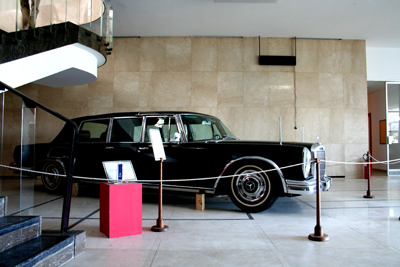
Tito Museum - Limousine
“Art, Life & Confusion” takes
place in a variety of venues, following the principle of a dialog. But the
great opening is at the Museum 25 May – the so-called Tito Museum, specially
built to host the presents received by the leader from the working class or
from foreign delegations and ambassadors. 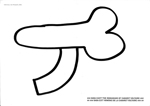 Rather, the crème de la crème of the
Balkan’s art scene is meeting here today. I bump into Dan Perjovschi. His
outfit is the embodiment of casual style. A grungy pink T-shirt with frankly
shabby light blue jeans and what one would call a real beard.
Rather, the crème de la crème of the
Balkan’s art scene is meeting here today. I bump into Dan Perjovschi. His
outfit is the embodiment of casual style. A grungy pink T-shirt with frankly
shabby light blue jeans and what one would call a real beard. 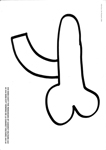 He even looks a
bit wild, à la 1980s. As he understands that I have visited the exhibition
“Dada East? The Romanians of Cabaret Voltaire” in
Zurich,
Perjovschi starts enthusiastically: “For me the greatest fun with this exhibition
was the comment of the scandalized Romanian ambassador to
Switzerland
when he saw the printed invitation postcard for the opening! See, it poses as a
bicycle saddle, but when you turn the picture around, whadda ya think it
becomes? It becomes what it becomes, see, that’s what it becomes! – Well, the guy from the embassy was horrified! –
Ha, ha…,” he is laughing like a schoolboy. “Ha, ha,” I laugh out myself. I ask
him whether he has heard of Mark Divo, of the art collective Krösus and the
debate around Dada and the space of Cabaret Voltaire in
Zurich. Perjovschi: “You know, that stuff
does not interest me. In contrast to this
Zurich
guy Mark Divo I am not a real revolutionary. I’m just a hooligan of an artist from the art system! I don’t do true revolutions, just make-believe! I like
pulling people’s legs!”
He even looks a
bit wild, à la 1980s. As he understands that I have visited the exhibition
“Dada East? The Romanians of Cabaret Voltaire” in
Zurich,
Perjovschi starts enthusiastically: “For me the greatest fun with this exhibition
was the comment of the scandalized Romanian ambassador to
Switzerland
when he saw the printed invitation postcard for the opening! See, it poses as a
bicycle saddle, but when you turn the picture around, whadda ya think it
becomes? It becomes what it becomes, see, that’s what it becomes! – Well, the guy from the embassy was horrified! –
Ha, ha…,” he is laughing like a schoolboy. “Ha, ha,” I laugh out myself. I ask
him whether he has heard of Mark Divo, of the art collective Krösus and the
debate around Dada and the space of Cabaret Voltaire in
Zurich. Perjovschi: “You know, that stuff
does not interest me. In contrast to this
Zurich
guy Mark Divo I am not a real revolutionary. I’m just a hooligan of an artist from the art system! I don’t do true revolutions, just make-believe! I like
pulling people’s legs!”
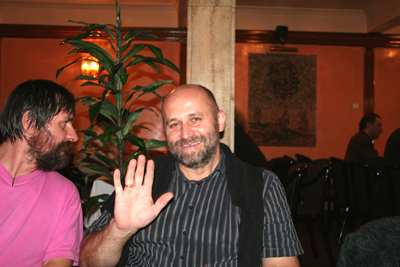
Nedko Solakov (to the right) and Dan Perjovschi
The day before, before the Great Opening at the “Tito Museum” we had the pleasure of being entertained by Nedko Solakov’s one-man show “HERITAGE” – his very own cunning little texts paraphrasing the space and loquaciously but cautiously making fun of accepted norms. This time in the space of a typical bourgeois house known as the “Legacy of Milica Zorić and Rodoljub Colaković.” The history of this truly upper-class house is a typical Balkan story. A constant cycle of rise and fall, of luster and decay. It is located in the most expensive neighborhood of Belgrade. The house is reminiscent of some saga or soap opera, à la “The Rich also Cry” or F. Scott Fitzgerald’s “The Great Gatsby.” After the communists came to power the house was confiscated from its refined first owners, who in their time were famous connoisseurs, collectors and patrons of art, in order to serve as a home to a lewd couple from the new elite, a posh combination of a famous woman artist and a party leader. The Serbian “Peron” organized no less lustrous balls from those of their predecessors. They also turned out to be just as generous patrons of the arts, if only in a different context, and no less admirers of French wines and boutiques than the previous owners. After this the villa falls under the control of the “Museum of Contemporary Art,” until Milošević’s people laid their hands on the property. Currently the house is in ruins. After having last served as a restaurant, and after a brutal murder was perpetrated inside, now it is being returned to the arts.
A guy is walking around the house feeling quite at home – Branislav Dimitrijević. Not only because he wrote the text for Solakov’s catalog of the great event, but presumably because he is a young and cool curator – ambitious, well-informed, speaking perfect English, with outstanding communication skills. A bright new star in the sky of the Balkan art scene. I first met this fellow in a rather awkward situation last winter in Zurich. Coincidentally I had the imprudence of arriving there with the scandalously famous Russo-Austrian extremists Alexander Brener and Barbara Schurz at his curatorial presentation at the F + F school of art. They had preyed on him with their standard routine “radical performance,” interrupting his lecture as they had done previously at the Istanbul Biennale, going so far as to call him a liar. I am hoping to remain incognito. But just as I am acting innocent, hiding behind a rather too transparent glass of white wine and pleasantly chatting with Nedko Solakov, he points to me angrily. I try to explain to him that all of us fit their category of liars, including myself. They’re just a real pain in the neck, that’s all! He is looking at me in evident distrust, I wonder why.
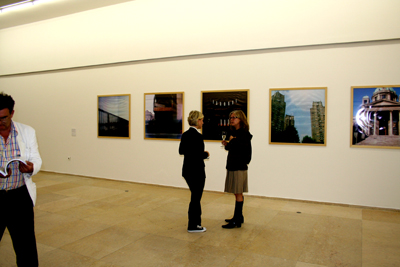
Marta Kuzma (to the left)
He is also the moderator of the panel discussion, which has brought together several important curators from the cream of the crop of the international art scene and the veterans from the “East-West guerilla art war” among their Balkan colleagues. Marta Kuzma makes attractive, rather short, but witty remarks – just what it takes. In the course of the discussion it becomes clear that her success and steep career over the past ten years is no accident. From the Ukrainian scene she first thrust herself on using the spring-board of Soros, curating Manifesta 5 in San Sebastian in 2004 with Massimiliano Gioni and joining the top ranks not only of the New York curators, but of the entire international art scene. She and Maria Lind, who currently acts as the director of the Swedish IASPIS exchange program, demonstrate such high class that the other curators in the discussion have a tough time around them – charming, bright, cool, of refined taste. Real tough women! I catch myself imagining them in the role of worthy partners in one of the versions of James Bond – women who besides their own charms have mastered all sorts of other martial arts, including punches below the belt. In contrast to Marta Kuzma’s distinguished business outfit – black pants, jacket, white shirt, sneakers, blonde short hair and that expression on her face that reminds me of Judith Foster’s in her role as super-cop in “The Silence of the Lambs,” Maria Lind is dressed in super-sexy bright red latex boots with worryingly high heels, a dress with wide black and white stripes hoop-skirt style with indiscreetly broad sleeves, the hit of the season as you know, tightened up at her waist in the manner of the 1960s. In her perfect appearance she is proudly holding on one arm her half-naked a-few-months-old son. Not only does the super-curator take care of the child all by herself throughout the project – together with the baby she also does not miss a single party, cocktail, opening or discussion.
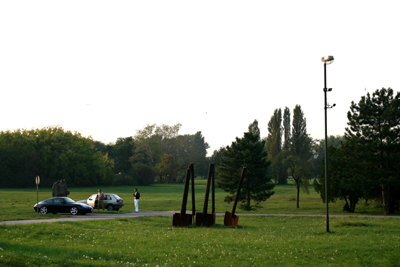
Meeting in front of the Museum of Contemporary Art, Belgrade
In a demonstration of collective dizziness some of the curators praise the global historical importance of the 1980s Balkan brand of conceptualism. They express their unanimous wish to define “professional standards for curatorial practices” in terms of accepted academic standards, through established, good art institutions. The greatest spectacle of the flashy October show however comes completely unexpected to me. A real breath of fresh air, or rather a hurricane from the West. It comes from an interview with Robert Storr, the director of the Venice Biennale 2007. The last time I have witnessed such eloquence was in a public lecture by the French philosopher Jacques Derrida in Sofia immediately after 11 September, on the birth of monsters from our own fears. Storr demonstrates an overwhelmingly high level of thinking. Not only from the distance of his physical stature and intelligence, but like a fiery meteorite at high speed he cuts through the atmosphere, blowing up the fundamental complex of questions, leaving behind a real crater in the field of contemporary Balkan curating, or Scandinavian, or German. To start with, he clarifies the position from which he speaks. And he does have a position! One that does not merely overlap with an institution. A position that comes from the feminist struggles and the gay movements. He emphasizes that for him in curatorial work the most important thing is the MESSAGE coming from an exhibition! Get REAL, the world is much larger, and there is more than one center and one periphery! He calls on radical, critical and political questions, while the audience keeps an icy silence. Storr’s spectacle has something of “Superman visits the primitives,” and so he defies the principle of dialog so dear to the organizers. Far from politically correct, but what a presence! I’m eagerly awaiting the Biennale next year in Venice.
As it turns out, only three of the participants in the curatorial seminar will be given a chance to visit the “Inner Museum” of Dragan Papić. The project is part of the great event, but is located, or rather, as I find out, crammed in his own home, so that its visibility is doubtful. The catalog, too, does not do it justice. I hurry up to indicate my interest, even if apparently there is no dispute over who will be allowed to go. Oh dear heavens, what a surprise! I find myself in an apartment in an old building in the center of Belgrade, stuffed with all sorts of objects. Dragan Papić works with existing objects of everyday use, objects from the flea market. In stark contrast to most of this scene he draws his arguments on, and situates his works in a theory of commodity critique – he calls it pop conceptualism, and relates it to Haim Steinbach and Jeff Koons. Desire takes a leading role in his obsession, but is further developed based on the specific morals of the local society. Aggression, irony and pleasure. Dragan points his hand to one of his pairs of objects: “These animals here represent the Serbs,” and that work raises the question of the “political and social freedom in Serbia.” He continuous without taking a breath: “I prefer speaking to people who make art rather than producing art myself or consuming what they are producing. In a house I own in a village near the border I set up a commune. This is where I would like to move my museum to. As much as I am having fun and truly enjoy the ‘speculative’ philosophy of the owner of the “Inner Museum” and the museum itself, the other curators appear to be not only annoyed, but somehow personally offended. At one point the pressure bursts after Papić’s confession: “I don’t know why society describes pedophilia in such hysteric ways, turning it into some kind of problem. How many are these cases, on the background of the entire other violence exercised by society on personalities. In this work with the Barbie heads torn off I found inspiration in this social phenomenon, in how the mass media treat these cases, how society uses them to its own ends; and over there – this small porcelain boy with a rabbit dress, that’s me – at the age of three or four years I realized I am in fact the ‘great pedophile,’ not the adult uncles accused of it.”
In the evening I happen to come across René Block. He is of the old school, a companion of Beuys and agent of Fluxus. He awfully reminds me of a capricious gastronome, or the older stately gentlemen from Luis Buñuel’s “The Discreet Charm of the Bourgeoisie” or Marco Ferreri’s “The Grande Bouffe.” Of course he never goes out to a bar, restaurant or disco with the mass of the participants. I seize my chance to be so close to him, the super-curator of the event, and ask him about Dragan Papić and his role in “Art, Life & Confusion.” He says he has never liked this type of artist and this type of archive, and that the decision to invite the “Inner Museum” was made under pressure. He himself has ended up agreeing to Papić’s participation only under the condition that he would not participate in the official venues of the exhibition. “He is ‘Unlimited!’ He wanted to fill everything here with his own obsessions. I did not agree, which is why I let him participate only there in his own private space! And whoever wants to can go and see it. But there, not here!” – René Block apparently is a great jokester – he soon becomes annoyed by serious conversations and tries to be ironic about the situation. After all he is in cheerful company, among which it would have been difficult not to notice a young and attractive Scandinavian artist who for the last three days has not stopped giggling. No kidding! She has been giggling all along: “Boss! Ha! Ha! Vodka! Boss! Ha! Ha! Vodka! Boss! Ha! Ha!” Well, Block and the girl are right, I say to myself: there are places in which however much you’d like to show off your wits, it is not very appropriate to ask whatever questions they may be! Certainly, they do not attest good manners and good taste. After all I am too much of a klutz to be able to twist my tongue and say something as cool as: “Boss! Ha! Ha! Vodka! Ha! Ha!” Which is why I only make a feeble attempt at contributing a: “Ha! Ha!”
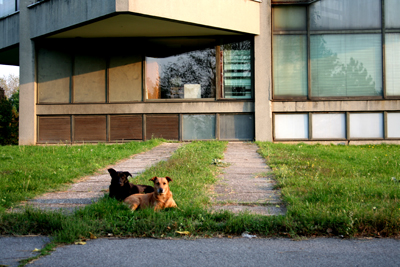
The Free Dogs Love Contemporary Art in Belgrade
This article was originally published in WeAreTheArtists No. 9 (January-April 2007)
